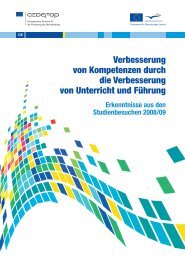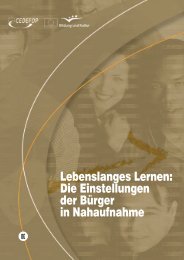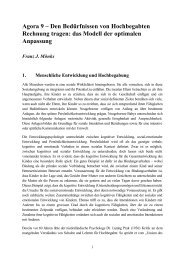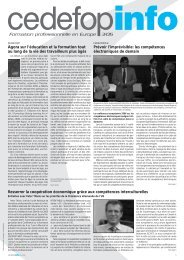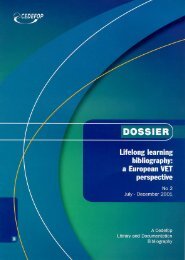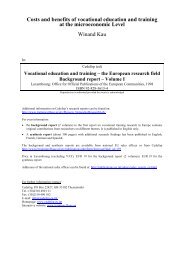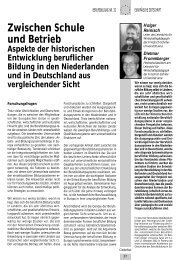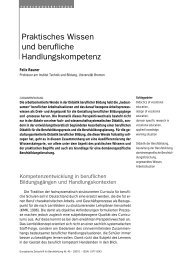Full text (pdf) - Cedefop - Europa
Full text (pdf) - Cedefop - Europa
Full text (pdf) - Cedefop - Europa
Create successful ePaper yourself
Turn your PDF publications into a flip-book with our unique Google optimized e-Paper software.
194<br />
European journal of vocational training<br />
No 42/43 – 2007/3 2008/1<br />
initial draft of, a reference framework structure for VET. This study (<strong>Cedefop</strong>;<br />
Coles and Oates, 2005) is regarded as a blueprint for the development of the<br />
European Qualifications Framework (EQF). Nowadays, ‘the emerging European<br />
Qualifications Framework and its learning outcomes-based grid of reference<br />
levels is regarded as an important support instrument for the effective<br />
implementation of the ECVET system’ (European Commission, 2006d;<br />
p. 12). The differences in the definition and role of learning outcomes in ECTS<br />
and ECVET (see table 3) are crucial in the development of lifelong learning.<br />
Lifelong learning is not a continuum without any disruptions or frictional losses.<br />
The first ‘threshold’ comes with the transition from general to vocational<br />
education. Secondly, the gap between the education system and the labour<br />
market often has to be bridged (the second ‘threshold’), and thirdly there are<br />
the crossovers between general, vocational and higher education. Questions<br />
arise here about continuity in the vertical conception of the EQF levels and,<br />
hence, about the role of the credit points relevant to credit systems. No such<br />
credit points appear in the European reference framework (EQF), which focuses<br />
on learning outcomes.<br />
Significance and role of credits<br />
Analysis of the subject of credit systems and qualifications frameworks shows<br />
that, sooner or later, a sensitive issue comes up in the discussion: namely credits,<br />
or how to calculate them in specific, quantifiable figures. In other words,<br />
the crucial question as to the role of credit points.<br />
The Bologna Agreement among universities defines credits as components<br />
of study programmes, and the numerical value of such credits - so-called credit<br />
points - is transferred. Agreements on the calculation and allocation of ECTS<br />
credit points serve as a general con<strong>text</strong> for organising student mobility (see<br />
Table 4). In ECVET, credits – or ‘learning credits’ – are the certified results<br />
of an examination of learning outcomes, taken abroad. ECVET credits are transferred<br />
(European Commission, 2006b). It falls to the competent authorities in<br />
the respective countries to establish the numerical value of ECVET credits.<br />
These competent bodies vary from one VET system to another and may be<br />
either ministries, chambers of industry and commerce, sectoral organisations<br />
or training providers.




